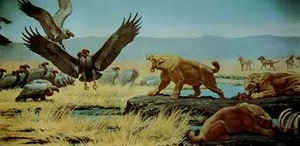
Tennessee Symbols
Tennessee State Fossil
Bivalve Mollusc

(Pterotrigonia (Scabrotrigonia) thoracica
Adopted on May 11, 1998.
In 1998, Tennessee designated an official State Fossil, the bivalve mollusc, (Pterotrigonia thoracica,) from the Late Cretaceous (Maastrichtian) age Coon Creek Formation. "Ptero," as it is affectionately known, inhabited the floor of an ocean that covered West Tennessee about 70 million years ago.
Tennessee State Fossil: Bivalve Mollusc

The campaign to have Ptero named as the State Fossil began in 1996 at The University of Tennessee at Martin. Spearheading the effort was UT Martin's GeoClub, a student organization dedicated to geological and geographic studies. Between 1996 and 1998, GeoClub members and geology professor Michael A. Gibson worked on determining a suitable nominee for state fossilhood and laying the groundwork for legislative action. With the supportive sponsorship of State Senator Roy Herron (D-Dresden), Ptero was named State Fossil in 1998 by the Tennessee legislature.
Characteristics of the Bivalve Mollusc

Bivalves are the class of molluscs that includes clams, oysters, mussels, and scallops. This bivalve lived during the Cretaceous Period, around 70 million years ago, when Tennessee was encroached upon by a shallow sea.
Animals of the Class Bivalvia are known as bivalves because they typically have two-part (The hard largely calcareous covering of a mollusc) shells,
with both parts being more or less symmetrical. The Class has 30,000 ((biology) taxonomic group whose members can interbreed) species, including (Edible
marine bivalve having a fluted fan-shaped shell that swim by expelling water from the shell in a series of snapping motions) scallops, (Burrowing marine
mollusk living on sand or mud) clams, (Marine mollusks having a rough irregular shell; found on the sea bed mostly in coastal waters) oysters and (Marine
or freshwater bivalve mollusk that lives attached to rocks etc.) mussels. The name is also spelled Bivalva. An old name for the Class is Pelecypoda.
Bivalves are exclusively aquatic; they include both marine and freshwater forms.
Bivalves lack a radula and feed by siphoning and filtering small particles from water. Some bivalves are epifaunal: that is, they attach themselves
to surfaces in the water, by means of a (Tuft of strong filaments by which e.g. a mussel makes itself fast to a fixed surface) byssus. Others are infaunal:
they bury themselves in sand or other sediments. These forms typically have a strong digging foot. Some bivalves can swim.
Tennessee House Joint Resolution No. 552
The bivalved invertebrate, Pterotrigonia (Scabrotrigonia) thoracica, became the official fossil of Tennessee when Governor Don Sundquist signed House Joint Resolution No. 552 on May 11, 1998.
Filed for intro on 03/02/98
HOUSE JOINT RESOLUTION 552
By Maddox
A RESOLUTION to designate Pterotrigonia (Scabrotrigonia)thoracica as the official fossil of Tennessee.
WHEREAS, the rocks of Tennessee preserve a rich array of fossil types, including invertebrates, vertebrates and plants from all regions of Tennessee,
and these fossils record life in Tennessee throughout the many different periods of our state's past; and
WHEREAS, fossils are the only record of the development and history of life on Earth and are thus a precious scientific and natural resource; and
WHEREAS, Tennessee fossils have been the focus of scientific study and collection for over 200 years, often figuring prominently in scientific advancements;
and
WHEREAS, recognition and conservation of our natural resources is important for future residents of the State of Tennessee; and
WHEREAS, the pursuit of fossils encourages awareness and appreciation of the natural wonders of Tennessee; and
WHEREAS, fossils have great popular appeal to students, collectors, and visitors to Tennessee, providing a common focus for the education of our citizens
and visitors and increasing public awareness and understanding of earth history and life on earth; and
WHEREAS, fossils and earth history comprise a major component of the Tennessee Science Framework for K-12 education, and thus provide Tennessee educators
with a valuable teaching tool; and
WHEREAS, the bivalved invertebrate Pterotrigonia (Scabrotrigonia) thoracica, which inhabited the ancient seas that once covered much of Tennessee,
is a unique fossil from the Coon Creek Formation of the Cretaceous geologic time period, which is well known to fossil collectors, researchers, and
educators in Tennessee; and
WHEREAS, Pterotrigonia (Scabrotrigonia) thoracica epitomizes the many species of extinct organisms whose fossil remains are so abundantly preserved
in the rocks throughout Tennessee, and is an easily recognizable symbol of Tennessee's fossil resources; and
WHEREAS, students and other interested persons have the opportunity to personally collect their own specimens of Pterotrigonia (Scabrotrigonia) thoracica
and experience the "hands-on" approach to learning about Tennessee's fossil resources; now, therefore,
BE IT RESOLVED BY THE HOUSE OF REPRESENTATIVES OF THE ONE-HUNDREDTH GENERAL ASSEMBLY OF THE STATE OF TENNESSEE, THE SENATE CONCURRING, That the fossil
bivalve Pterotrigonia (Scabrotrigonia) thoracica of the Coon Creek Formation is hereby designated as the official fossil of Tennessee.
BE IT FURTHER RESOLVED, That the Secretary of State is directed to include pertinent information about the fossil bivalve Pterotrigonia (Scabrotrigonia)
thoracica, including its designation as the official state fossil, in the 1999-2000 edition of the Tennessee Blue Book.
BE IT FURTHER RESOLVED, That an enrolled copy of this resolution be transmitted to the Secretary of State.
Taxonomic Hierarchy: Bivalve Mollusc
Kingdom: AnimaliaPhylum: Mollusca
Class: Bivalvia
Order: Trigoniida
Superfamily: Trigonioidea
Family: Trigoniidae (Lamarck)
Genus: Pterotrigonia
Species: Pterotrigonia thoracica

Some states that lack a "state fossil" have nevertheless singled out a fossil for formal designation such as a state dinosaur, rock, gem or stone.






